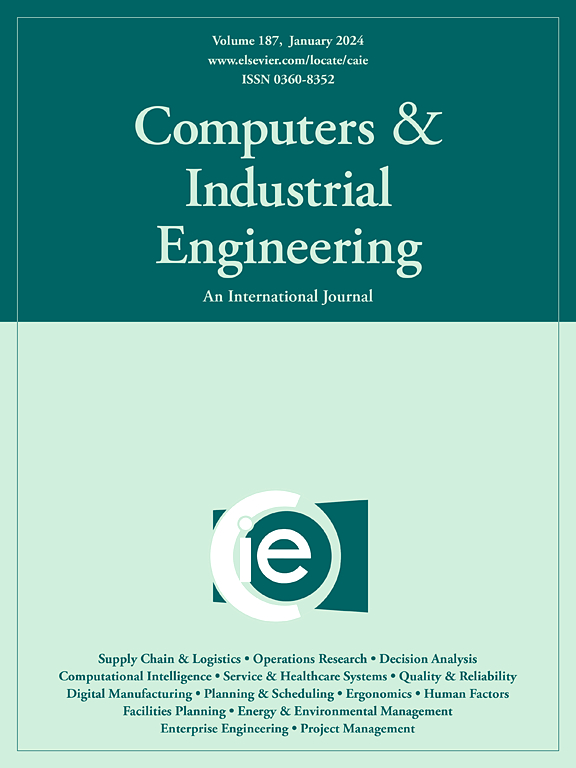基于实时需求预测的共享型自动驾驶汽车可扩展出行匹配与调度模型
IF 6.7
1区 工程技术
Q1 COMPUTER SCIENCE, INTERDISCIPLINARY APPLICATIONS
引用次数: 0
摘要
共享自动驾驶电动汽车(saev)在降低出行成本和缓解交通拥堵方面具有巨大的潜力。然而,现有的SAEV调度算法往往采用短视策略,且计算复杂度高。提出了一种将需求预测与实时决策相结合的动态配车与车队调度分层框架。在较低层次上,使用基于注意力的时空图卷积网络构建高精度乘客需求预测模型,利用六边形网格划分和历史旅行数据生成细粒度、时间敏感的预测。基于这些预测见解,上层决策模块将乘车匹配任务建模为马尔可夫决策过程,并在多智能体强化学习框架中协同这些信息,使用改进的Double Deep Q-Network (Double DQN)算法进行解决。在多智能体仿真环境中使用成都真实旅行数据进行的实验证明了该集成框架的有效性。结果表明,需求预测模型的均方根误差为1.046,出行匹配决策方法仅以76.6%的自动驾驶汽车车队完成了93.76%的出行订单,显著提高了车辆利用率。此外,当同时启用拼车和需求感知调度功能时,与不启用这些功能相比,该模型的订单完成率提高了15%。这些结果强调了该框架将高保真预测与可扩展决策相结合的能力,为基于saev的城市交通系统提供了强大的自适应解决方案。本文章由计算机程序翻译,如有差异,请以英文原文为准。
Scalable ride-matching and dispatching model for shared autonomous electric vehicles with real-time demand prediction
Shared Autonomous Electric Vehicles (SAEVs) hold significant potential for reducing travel costs and alleviating traffic congestion. However, existing SAEV dispatch algorithms often employ shortsighted strategies and suffer from high computational complexity. This paper proposes a hierarchical framework for dynamic ride-matching and fleet dispatching that unifies demand forecasting and real-time decision-making. At the lower level, a high-precision passenger demand prediction model is constructed using an attention-based spatial–temporal graph convolutional network, leveraging hexagonal grid partitioning and historical travel data to generate fine-grained, time-sensitive forecasts. Building on these predictive insights, the upper-level decision module models the ride-matching task as a Markov decision process and synergizes this information within a multi-agent reinforcement learning framework, solved using an improved Double Deep Q-Network (Double DQN) algorithm. Experiments using real-world travel data from Chengdu in a multi-agent simulation environment demonstrate the effectiveness of the integrated framework. Results show that the demand prediction model achieves a root mean square error of 1.046, and the ride-matching decision method completes 93.76% of travel orders with only 76.6% of the SAEV fleet, significantly improving vehicle utilization. Additionally, when enabling both ride-sharing and demand-aware dispatching, as opposed to operating without these functionalities, the model achieves a 15% higher order completion rate. These results underscore the framework’s ability to couple high-fidelity forecasting with scalable decision-making, offering a robust and adaptive solution for SAEV-based urban mobility systems.
求助全文
通过发布文献求助,成功后即可免费获取论文全文。
去求助
来源期刊

Computers & Industrial Engineering
工程技术-工程:工业
CiteScore
12.70
自引率
12.70%
发文量
794
审稿时长
10.6 months
期刊介绍:
Computers & Industrial Engineering (CAIE) is dedicated to researchers, educators, and practitioners in industrial engineering and related fields. Pioneering the integration of computers in research, education, and practice, industrial engineering has evolved to make computers and electronic communication integral to its domain. CAIE publishes original contributions focusing on the development of novel computerized methodologies to address industrial engineering problems. It also highlights the applications of these methodologies to issues within the broader industrial engineering and associated communities. The journal actively encourages submissions that push the boundaries of fundamental theories and concepts in industrial engineering techniques.
 求助内容:
求助内容: 应助结果提醒方式:
应助结果提醒方式:


